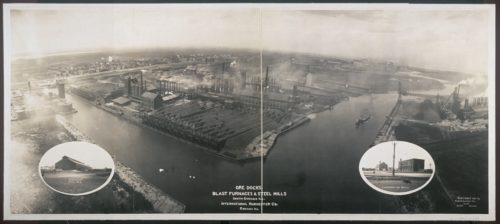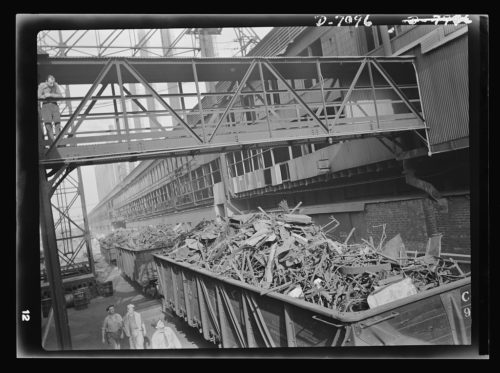The History of Chicago’s Steel Mills & Its Immigrants
Leave a Comment(c. 1907) Pic courtesy of Library of Congress
In 1952, the Chicago Tribune reported that the city of Chicago produced more steel than the entire country of Great Britain. This remarkable feat was achieved through the combined efforts of the city’s numerous steel mills.
The long and colorful history of Chicago’s steel mills begins in 1857 with the opening of the city’s first steel mill, North Chicago Rolling Mill Company. Within three years, the mill became one of the biggest companies in the area, with its primary focus on making rails for the railroad.
Slowly but surely, more steel mills opened for business. A majority of them opened their doors on the South Side, including:
- Wisconsin Steel. Originally known as the Joseph H. Brown Iron & Steel Company, the mill went through several names before settling on Wisconsin Steel. It ultimately shut down in 1980 after more than 100 years in operation.
- Republic Steel. Business for Republic Steel grew steadily after the Second World War, but the mill is best known because of the Memorial Day Massacre in 1937. Ten people were killed and 105 injured when a peaceful protest in response to the company’s refusal to recognize the steel workers union turned deadly.
- Acme Steel. Acme Steel was in operation until 2001, when it closed after several years in bankruptcy. It was home to Chicago’s last blast furnace, which was torn down a few years later.
- Youngstown Sheet & Tube. Originally known as Iroquois Steel, Youngstown was one of four companies that went on strike—resulting in the Memorial Day Massacre.
- South Works. This South Side plant was an expansion of the North Chicago Rolling Mill. It was once the largest mill in the area, employing nearly 20,000 people.
Over time, all of these mills became part of U.S. Steel, the world’s largest business enterprise at the time and founded by none other than J. P. Morgan, the steadfast financier who dominated the corporate landscape throughout The Gilded Age.
As the demand for steel grew, so too did the demand for labor. To fill the vacant jobs in the steel mills, immigrants began to flock to the area, resulting in significant overcrowding in parts of the city and surrounding towns.
Chicago’s Immigrants Begin to Arrive
For several decades, the high wages offered by the steel mills attracted immigrants from around the world. In the 1870s and 1880s, people came from Ireland, Scotland, and Germany to find work in the blossoming steel industry. From the late 1800s until World War I, Polish and Serbian immigrants began to arrive. After the war, they came from the southern United States and Mexico.
The growth of Chicago’s steel industry can be largely attributed to the city’s close proximity to the Great Lakes and the Calumet River. This location provided access to both an immigrant workforce from the surrounding neighborhoods and easy transportation for raw materials and finished goods.
As the number of steel workers in the area grew, they began to recognize the need for safe working conditions and fair pay and attempted to organize to make their demands. When some of the smaller steel companies, known as “Little Steel” (in opposition to U.S. Steel— “Big Steel”), refused to sign a union contract, the Steel Workers Organizing Committee (SWOC) staged a strike which was more than unsuccessful: it was tragic. Police fired on the unarmed crowd of protesters, resulting in 10 deaths and more than 100 injuries, an event known as the Memorial Day Massacre.
The Steel Mills Begin to Close
As modern American industry began to change over the decades, one by one, the steel mills began to close.
Wisconsin Steel shut down in 1980 without warning its employees, leaving more than 3,000 people suddenly without a means of supporting themselves and their families. South Works closed its doors in 1992 after two decades of downsizing. After enduring several bankruptcies throughout the 1980s and 1990s, Republic Steel ended all of its operations in the early 2000s.
Although shutting down these massive companies had an overwhelming impact on the community and the people who relied on the mills to make a living, even as they went away, the immigrants remained. They had made their homes in the The Windy City.
Manor Tool & Manufacturing + Chicago
Chicago’s sprawling steel industry called for additional services to support steel production. With that in mind, Manor Tool opened in 1959 as a tool and die shop.
Since then, we have expanded our service offerings to include metal stamping, specializing in punching, bending, forming, and deep drawn stamping for prototype to high volume production runs. We work with a wide range of metals, including stainless steel, carbon steel, and much more. Our metal stamping capabilities include:
We also offer metal fabrication capabilities, such as:
- Forging
- Extrusion
- Punching
- Welding
- Drilling
- Milling
- Turning
At Manor Tool, we’re proud to be a part of the long tradition of steel production and metal stamping in Chicago, and we look forward to helping shape the industry for years to come. We serve the greater Chicago area and beyond, so we invite you to contact us and request a quote to learn more.





